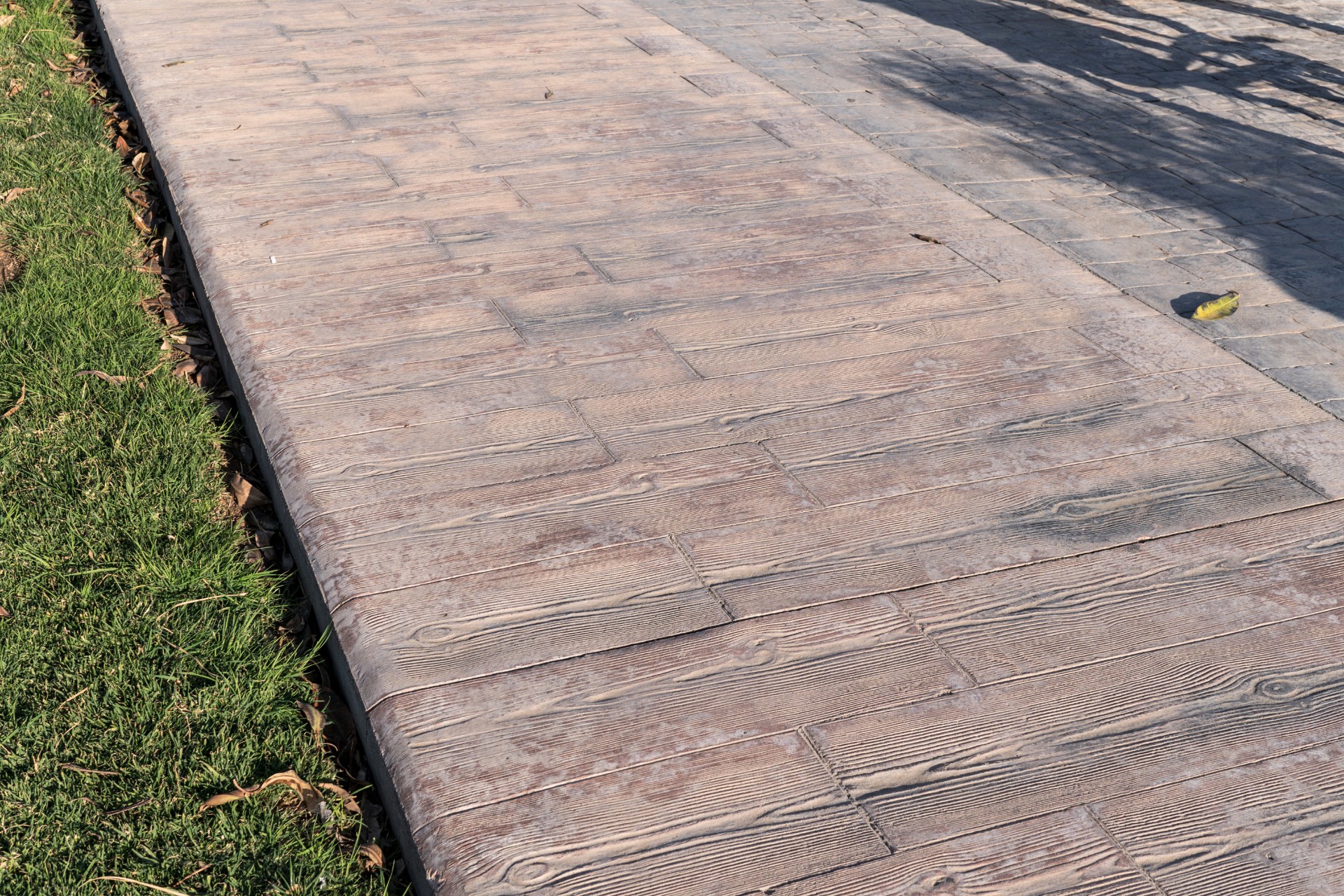While there are many variations within each category, the basic types of stamped concrete include:
- Wood
- Brick
- Cobblestone
- Slate
- Flagstone or fieldstone
- Tile
- Textured mats
Stamped concrete offers a versatile and cost-effective solution for enhancing the aesthetic appeal of outdoor spaces.
Mimicking the textures of various materials, stamped concrete provides a long-lasting alternative to traditional paving options with nearly limitless customization options.
Types of Stamped Concrete
Stamped concrete allows you to achieve the look of different materials without compromising durability and affordability.
Wood
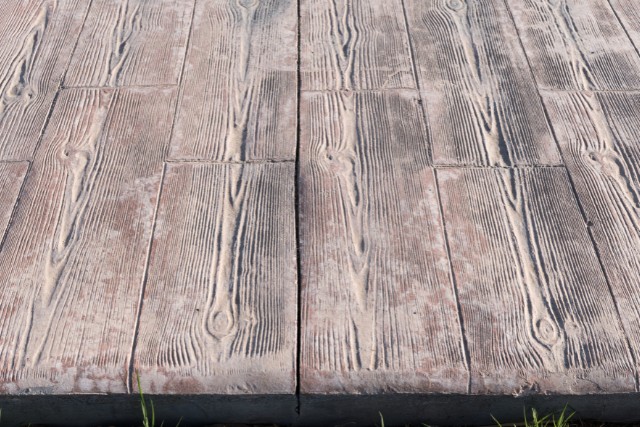
Wood grain patterns in stamped concrete have surged in popularity for those seeking the charm and allure of natural wood without the accompanying maintenance challenges.
This aesthetic choice imparts a rustic charm to outdoor spaces, making it a favored option for patios, porches, walkways, and even pool decks.
The appeal lies in the authentic texture it brings and its ability to seamlessly blend with various architectural styles.
Choose from narrow or broad wood plank designs to replicate the appearance of reclaimed barn wood, bridge planks, and more.
Unlike real wood, stamped concrete requires minimal upkeep, eliminating concerns about rotting, splintering, or the need for regular staining.
This makes it an excellent choice for homeowners looking to infuse a touch of nature into their surroundings without sacrificing durability or spending extensive time on maintenance (although sealing will still be necessary).
Brick
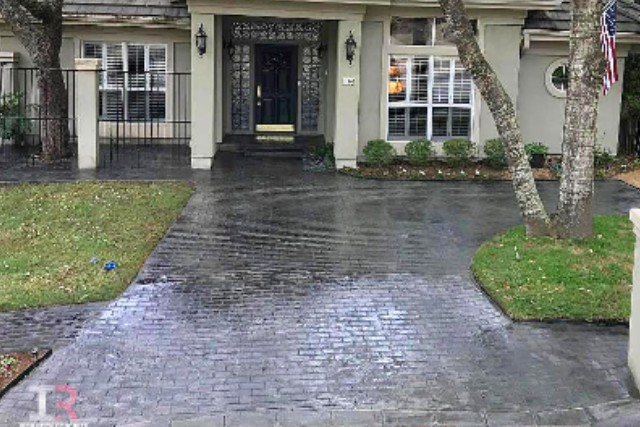
Stamped concrete effortlessly captures the timeless elegance of traditional brick in various styles and colors.
Whether you prefer a classic herringbone pattern, a basket-weave pattern, or a more contemporary running bond, stamped concrete provides a durable and cost-effective option and the flexibility to fully customize according to your tastes.
Real brick tends to deteriorate over time and require extensive repairs, but stamped concrete is known for its longevity and resilience.
Stamped concrete provides an economical alternative to real brick without compromising on the charming, classic appeal associated with brickwork.
Cobblestone
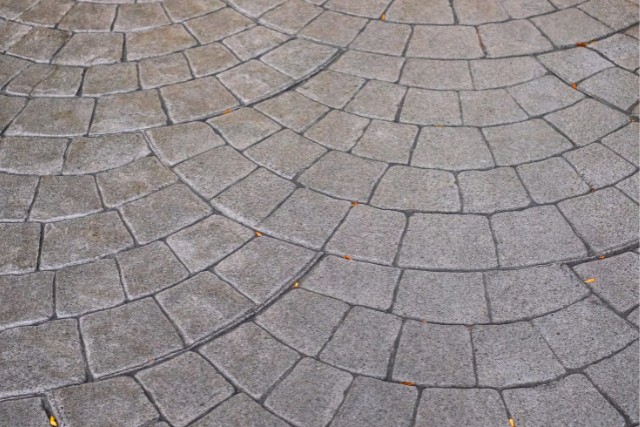
Transform your outdoor space with the timeless allure of stamped concrete cobblestone patterns.
Emulating the rustic charm of historic cobblestone streets, this option introduces a touch of Old-World elegance to your pathways, driveways, or patios.
Stamped concrete captures the irregular shapes and textures of cobblestone with remarkable precision, creating a visually captivating environment.
The durable surface withstands the test of time, providing a long-lasting solution without the need for extensive maintenance.
Eliminate the labor-intensive process of installing individual cobblestones, and welcome an affordable and resilient alternative that exudes character and sophistication in every detail.
Slate
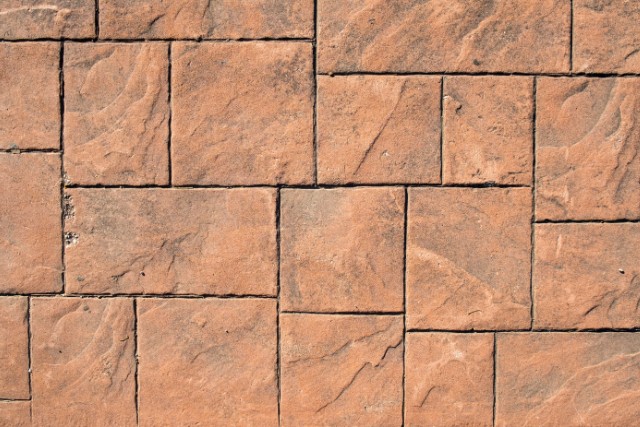
Slate patterns in stamped concrete, including popular variations like Ashlar and Italian, provide a sophisticated and modern aesthetic.
The inherent texture and fine details of natural slate are meticulously replicated, offering a versatile choice for both contemporary and traditional settings.
Stamped concrete allows you to explore various colors and patterns, giving you the freedom to personalize your outdoor space with the enduring appeal of slate without the high cost and intricate installation associated with the natural stone.
Flagstone/Fieldstone
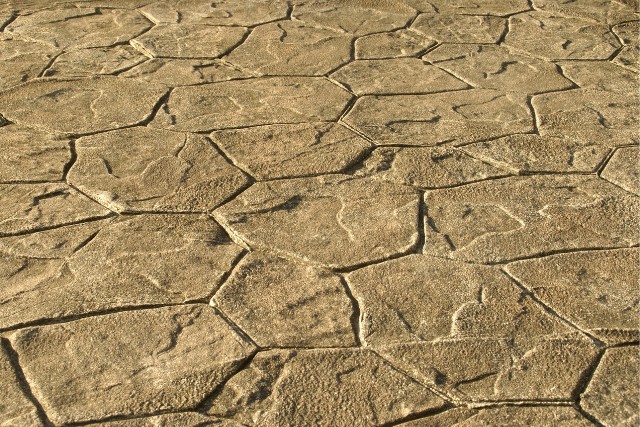
Stamped concrete excels in imitating the natural and irregular shapes found in flagstone and fieldstone. This option adds character and a touch of rugged beauty to your outdoor design.
The flexibility of stamped concrete allows for customization, ensuring that your flagstone or fieldstone-inspired patterns seamlessly integrate with your landscape.
Enjoy the visual richness of these patterns without the challenges of sourcing and installing natural stones.
Tile
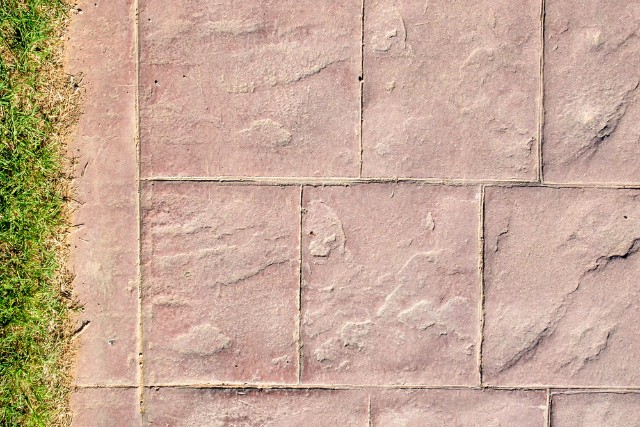
The versatility of stamped concrete extends to replicating intricate tile patterns, offering a customizable solution for those seeking a refined and elegant look.
Whether you prefer the charm of Mediterranean tiles or the simplicity of geometric patterns, stamped concrete allows you to achieve the desired aesthetic without the complexities of installing individual tiles.
This option is perfect for creating vibrant and eye-catching surfaces around pool areas, patios, or outdoor kitchens.
Texture Mats
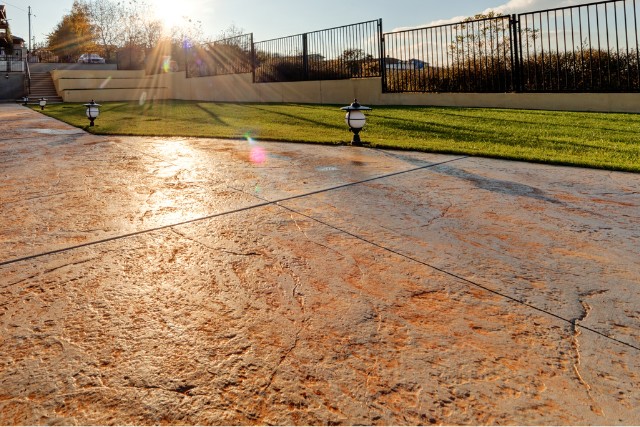
Texture mats play a pivotal role in achieving seamless patterns in stamped concrete. These mats enable the creation of surfaces that not only look authentic but also feel natural underfoot.
By eliminating visible joints and seams, texture mats enhance the overall aesthetic, making stamped concrete an appealing choice for those who appreciate a cohesive and uninterrupted appearance in their outdoor spaces.
Explore the possibilities of texture mats for achieving a wide range of textures, from smooth and polished to more rugged and textured surfaces.
Additional Options for Further Customization
Choosing stamped concrete provides practically endless customization opportunities to tailor your outdoor spaces according to your unique preferences.
Decide on your desired size and shape, choose your stamping pattern, and then enhance your vision with these additional customization options.
Border Patterns
Elevate the visual impact of your stamped concrete by incorporating distinctive border patterns. Borders serve as elegant frames, adding a finishing touch to your design.
Whether you opt for contrasting colors or complementary textures, border patterns provide a subtle yet impactful way to define and enhance the edges of your stamped concrete surface.
Brick remains a popular choice, but cobblestone, wood, scroll accents, or any other stamping design can be used to enhance the main pattern.
Color Choices
Stamp your personality into your outdoor spaces with a myriad of color choices available in stamped concrete.
From earthy tones that blend seamlessly with natural surroundings to bold hues that make a statement, the color options are virtually limitless.
Consider the overall aesthetic you want to achieve, and select colors to create a personalized and inviting outdoor environment.
Using only one color can produce an unnatural look. Consider selecting highlights to complement the base color, or use multiple base colors to mimic the natural coloration of the material you are replicating.
Ask your contractor to demonstrate the finished effect before making your final decision.
Factors To Consider
In the planning stages of your stamped concrete project, it’s crucial to weigh several factors to ensure the best possible optimal outcome.
Consider the following elements carefully, and work closely with your contractor to be sure your vision can indeed become reality.
Cost
Stamped concrete is a more affordable alternative compared to natural stone, pavers, or traditional brick. While offering the same aesthetic appeal, stamped concrete provides a budget-friendly option without compromising durability.
There are, of course, cheaper options, such as inexpensive, budget-quality pavers, but over the long term, the strength, customization options, and low maintenance needs make stamped concrete the superior choice.
Maintenance
Stamped concrete is celebrated not only for its visual versatility but also for its low-maintenance characteristics.
Unlike natural materials such as wood or real stone, stamped concrete requires minimal upkeep. Regular cleaning and periodic sealing are usually sufficient to preserve its beauty and avoid repairs.
Project Size
The size of your project plays a pivotal role in determining the stamped concrete pattern that suits it best.
Larger areas may benefit from expansive patterns like slate or fieldstone to create a grand and cohesive look.
Conversely, smaller spaces might be better complemented by intricate patterns such as wood grain or tile. Tailoring the pattern to your project size ensures a harmonious and proportional design.
Concrete Can Be Slippery
Consider the safety aspect of your stamped concrete surface. Certain patterns and finishes may be more prone to slipperiness, especially in wet conditions.
If your stamped concrete will be around pool areas or in regions with frequent rainfall, opting for a deeply and densely textured surface or an anti-slip additive during the sealing process can enhance safety without compromising aesthetics.
Know that a thick or film-forming layer of sealer will produce a glossy finish but will greatly increase the slickness of the surface, especially when wet.
Style of Home and Landscape
Harmonizing your stamped concrete choice with the existing style of your home and landscape is key to achieving a cohesive design.
Whether your property boasts a modern, traditional, or eclectic aesthetic, selecting a pattern and color that complements your surroundings enhances the overall visual appeal.
Consider matching existing structures such as fire pits, walkways, or architectural elements to create a unified and cohesive outdoor space.
Your Climate
Your local climate influences not only the aesthetic considerations but also the practical aspects of stamped concrete.
Lighter-colored concrete tends to stay cooler in direct sun during the summer, which makes it ideal for pool areas.
Darker hues may absorb more heat, which could be used to your advantage if placed strategically but would not be a good choice for areas where summertime barefeet are likely.

